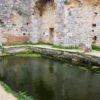Miletus
₺1.00
There is a great range of possibilities when it comes to prayer during a tour to the ancient Biblical sites.
| Categories: | Paul’s Journeys, Tours |
|---|---|
| Tags: | 7 Churches, Cappadocia, istanbul, Tour, Turkey |
In the afternoon we visit the Grand Bazaar and enter a labyrinth of streets with booth-like shops spilling their wares into the passageway. Here you banter and bargain with merchants who would just as soon chat and sip tea with you as to sell their goods. Relax to the experience and soak in the charm of Old Turkey. Overnight in Istanbul.
Pergamum (Bergama) is another site to astound us. The location of much excavation, it is easy to appreciate the beauty of the ancient city. According to John the church here was in danger not only from the state but also the more subtle temptation to hold to the beliefs of Balaam (Revelation 2:14-15). From the mountainside we descend to the valley and tour the ancient medical center, theAsclepion, established by the great physician, Galen. A short journey away, in Thyatira (Akhisar), are the ruins of an ancient temple, perhaps to Apollo, parts of a colonnaded road and a church. Further excavations here are unlikely and once you visit, you will understand that decision. In Scripture we associate the city with Lydia of Thyatira, a seller of purple, whom Paul met in Philippi. The church here suffered threats from within—indulgence and lack of moral responsibility (Revelations 2:23; 26-28). Overnight in Izmir.
The tour includes a visit to St. John’s Basilica built by Emperor Justinian in the 6th century. Under the central dome lays the grave of the Apostle John.
The Ephesus Museum is one of Turkey’s best. The two greatest exhibits are the marble statues of Artemis. One is from the 1stcentury AD and the other 2nd century AD. Other marble and bronze statues are displayed along with jewelry, coins and other artifacts of the Ancient World. Overnight in Kusadasi. (Option to fly back to Istanbul and overnight there or catch an onward flight in the evening.)








